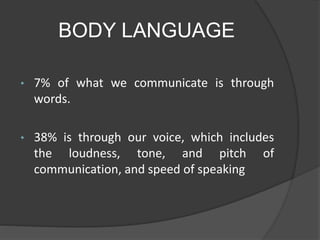
Body language Presentation1.pptx
- 1. BODY LANGUAGE • 7% of what we communicate is through words. • 38% is through our voice, which includes the loudness, tone, and pitch of communication, and speed of speaking
- 2. 55% of what we communicate is conveyed through our body language.
- 4. What is Body Language? Body language is the communication of personal feelings, emotions, attitudes and thoughts through body movements, gestures, postures, facial expressions, walking styles, positions and other demeanors, either consciously or involuntarily, whether accompanied by or unaccompanied by verbalization.
- 5. Body Language Reflects Emotions Body language is important because it reflects a person’s emotions. It is important to understand that more than a particular part of our body signaling certain emotions, it is a combination of all our non-verbal actions (clusters) that collectively reflect our response.
- 6. For Example. . Attentive Body Language. This includes Eye contact with the speaker Mild nods of head at periodic intervals A slightly tilted head indicates interest. Body slightly bent forward towards the speaker.
- 7. UPSET Body language signals to identify ‘upset’ signals are as follows: Tightened jaws. Frown on the forehead Avoiding eye contact with others or having a very cold stare. Walking impatiently, with head down facing the ground, and annoyed face.
- 8. Bored Bored people usually look everywhere other than at the speaker. They frequently look at their watch or check sms/e-mails on their mobiles. They give blank stares when their eyes are open, and have their body significantly bent back to a degree that conveys lack of interest.
- 9. Defensive A person under attack immediately assumes a defensive posture. Typical body language gestures associated with a defensive posture are: Tightly folded arms. Crossed legs Wandering eyes Showing nervousness while giving excuses.
- 10. Open Palm Gesture One of the most valuable ways of discovering whether someone is being open and honest or not is to look for palm displays. For example, when people wish to be totally open or honest they will hold one or both palms out to the other person and say something like, ‘Let me be completely open with you’ (Figure). Like most body language, this is a completely unconscious gesture, one that gives you a feeling or hunch that the other person is telling the truth.
- 11. • Sales people are often taught to look for the customer’s exposed palms when he gives reasons why he cannot buy the product, because only valid reasons are given with exposed palms.
- 12. HANDSHAKE One of three basic attitudes is transmitted through the handshake. These are: 1. dominance: ‘This person is trying to dominate me. I’d better be cautious’. 2. submission: ‘I can dominate this person. He will do as I wish’. 3. Equality: ‘I like this person. We will get on well together’.
- 13. The Glove Handshake The glove handshake is sometimes called the politician’s handshake. The initiator tries to give the receiver the impression that he is trustworthy and honest. When this technique is used on a person you have just met, the receiver feels suspicious and cautious about the initiator’s intentions.
- 14. The Superiority Confidence Gesture Several prominent male members of the British Royal Family are noted for their habit of walking with their head up, chin out and one palm gripping the other hand behind the back. The headmaster of the local school when he is walking through the school yard, senior military personnel and others in a position of authority.
- 15. Pointers (1) The person’s head is turned towards you and facial signals such as smiling and nodding are evident. (2) The person’s body and feet are pointing away from you, either towards another person or towards an exit. The direction in which a person points his or her torso or feet is a signal of where he or she would prefer to be going.
- 16. The higher the back of the chair, the greater the power and status of the person sitting in it.
- 17. Carbon Copies and Mirror Images The next time you attend a social function or go to a place where people meet and interact, take note of the number of people who have adopted the identical gestures and posture of the person with whom they are talking. This ‘carbon copying’ is a means by which one person tells the other that he is in agreement with his ideas and attitudes.
- 18. This copying also occurs among good friends or people at the same status level and it is common to see married couples walk, stand, sit and move in identical ways. Significance: The significance of carbon copying can be one of the most important non-verbal lessons we can learn, for this is one way that others tell us that they agree with us or like us. It is also a way for us to tell others that we like them, by simply copying their gestures.
- 19. Picking Up and Understanding Non-Verbal Signals -Case in Point Lauren sighed. She'd just received an email from her boss, Gus, saying that the product proposal she'd been working on wasn't going to be signed off after all. It didn't make any sense. A week ago she'd been in a meeting with Gus and he'd seemed really positive about it all. Sure, he hadn't made much eye contact, and he kept looking out of the window at something. But she'd just put that down to him being busy. And, he'd said that "the project will probably get the go-ahead."
- 20. If Lauren had known a little bit more about body language, she would have realized that Gus was trying to tell her that he wasn't "sold" on her idea. He just wasn't using words to tell her that.